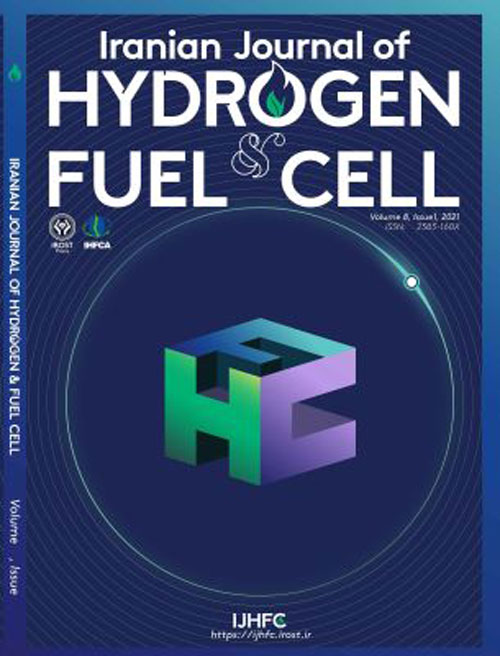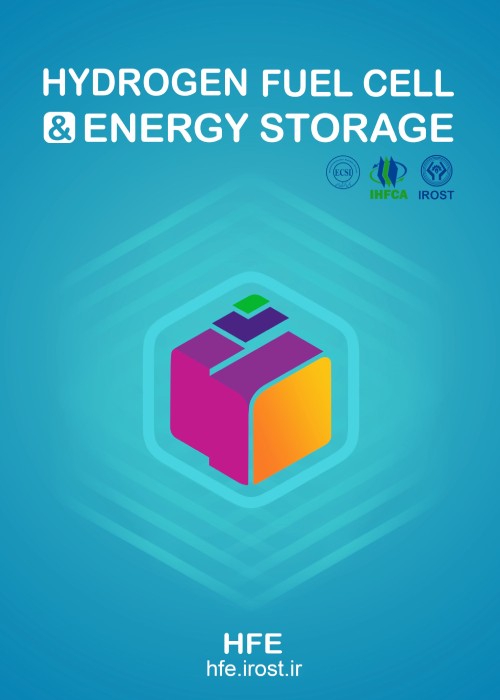فهرست مطالب

Journal of Hydrogen, Fuel Cell and Energy Storage
Volume:9 Issue: 1, Winter 2022
- تاریخ انتشار: 1401/03/16
- تعداد عناوین: 6
-
-
Pages 1-18In this study, the plastic deformation of a metallic bipolar plate with a serpentine flow field was investigated during the stamping process. The strain path and thickness distribution in 304 stainless steel bipolar plates with a thickness of 0.1 mm were determined. To achieve this purpose, the process was simulated by the ABAQUS commercial finite element code, and the validity of the results was evaluated by experimental tests under simple and lubricated conditions. According to the results, the flow of material has a significant effect on the thickness distribution of the central and lateral channels, and the thickness reduction percentage of the central channel in the longitudinal, diagonal, and transverse directions is higher than the lateral one. The maximum thickness reduction in the central channels is observed in the longitudinal direction, while the diagonal direction is considered as a critical direction for lateral channels. Due to the existence of the equibiaxial tension strain path in the diagonal direction, significant thickness reduction is observed in both the side and the rib zone of the channels. However, using lubricant led to a decrease in the thickness reduction percentage by improving the flow of material into the die cavity. Moreover, under lubricated conditions, the critical area is transferred from the side area of the channel in the longitudinal direction to the rib area in the diagonal directionKeywords: Polymer electrolyte membrane fuel cell, Metallic bipolar plate, Metal forming, Thickness distribution, Strain path
-
Pages 19-25In this paper, the capability of the Computational Fluid Dynamics (CFD) approach is evaluated to reliably predict the fluid dynamic and the separation performance of Pd membranes modules for gas mixture separation. In this approach, the flow fields of the pressure and velocity for the gas mixture and the species concentration distribution in the selected three-dimensional domains are obtained by simultaneous and numerical solution of continuity, momentum, and species transport (especially, gas-through-gas diffusion term that derived from the Stefan–Maxwell formulation) equations. Therefore, the calculation of the hydrogen permeation depends on the local determination of the mass transfer resistance caused by the gas phase and membrane, which is modeled as a permeable surface of known characteristics. The applicability of the model to properly predict the separation process under a wide range of pressure, feed flow rate, temperature, and gas mixtures composition is assessed through a strict comparison with experimental data. Moreover, in this work, the influence of inhibitor species on the module performance is discussed, which is obtained by implementing the CFD model. The results of the simulation showed that increasing the pressure on the feed side increases the molar fraction of hydrogen gas, the feed inlet flow on the shell side, and the hydrogen permeation through the membrane in the tube side. Comparison of simulation results with laboratory data showed good agreement. The model was obtained with an error of less than 3% at 450K and below 6% for 475K and 500K.Keywords: Hydrogen Separation, fuel cell, Pd-based membrane, Computational Fluid Dynamics (CFD)
-
Pages 27-38Liquid propellant missiles are commonly applied to launch satellites that must be located in upper orbits. These systems normally use hydrogen and oxygen propellants that are non-hypergolic mixtures. In this study, the test results of a designed hydrogen/oxygen engine were evaluated, and a designed spark igniter was successfully used to start the engine. Seven hot tests were carried out to determine the performance of the engine. The effect of oxygen to fuel ratio (O/F ratio) at a constant combustion chamber pressure (800 kPa) showed that the maximum value of the specific impulse (Isp) and characteristic velocity (C*) occurs at an O/F ratio of about 2.8. Experimental tests at the constant O/F ratio of 2.8 showed that performance parameters, such as Isp and C*, were enhanced when the chamber pressure was increased. However, the trend was sluggish at pressures higher than 800 kPa.Keywords: Hydrogen, Oxygen Engine, Performance, Specific Impulse, Characteristic Velocity
-
Pages 39-52A PEM fuel cell is considered a system with a complex mechanical structure due to a large number of components with different dimensions and materials. Understanding this structure is essential to design fuel cells against dynamic loads such as shock and vibration. In this paper, modal analysis of a 500 W fuel cell with an active area of 225 has been performed. The fuel cell has been excited in transverse and longitudinal directions, and the outputs of the sensors were recorded at several points. Using the Poly reference least-squares complex frequency-domain method, the first ten transverse and longitudinal natural frequencies and mode shapes of the model were determined. Modal analysis revealed that the lack of structural integrity, the layered structure, and the layer connection type results in the formation of mode shapes that do not match conventional predictions. Comparison of the numerical and experimental results showed a maximum difference of 15%. Furthermore, the results illustrated that changing geometrical and mechanical properties of the membrane by 45% have a negligible effect on the natural frequency of the fuel cell. Allowing for this fact will result in a significant reduction in the computational cost of large-scale fuel cells analysis.Keywords: Polymer electrolyte membrane fuel cell, Modal analysis, Vibrational properties, Natural frequency, Finite element simulation
-
Pages 53-68This study presents the energy, exergy, and economic evaluation of recovering energy from a modified Kalina power-cooling system to provide heating and hydrogen. An ORC is employed to use the waste heat of the Kalina cycle, and the generated power is transmitted to a PEM electrolyzer for hydrogen production. Furthermore, the waste heat of the separator outlet is recovered through a new heat exchanger to provide heating. The results show that the proposed system can produce 317 kW power, 714.7 kW cooling, 50.3 kW heating, and 4.491 kg/h hydrogen. Moreover, the exergoeconomic analysis indicates that the PEM electrolyzer, the cascade heat exchanger, and the vapor generator have the highest cost rate among the system components. Additionally, a parametric study was performed on the system to investigate the variation of some key parameters, including the maximum operating pressure, separator II pressure, ammonia mass fraction in a basic solution, and pinch point temperature difference in the cascade heat exchanger for the thermodynamic and economic performance of the system.Keywords: Kalina cycle, PEM electrolyzer, multigeneration, exergoeconomic analysis
-
Pages 69-85
Among direct alcohol fuel cells, the ethanol fuel cell is considered the most acceptable in terms of safety and power density. In this research, a Pt/CNFs-GNPs /GDL electrode was developed using GNPs and CNFs as a supporting medium on carbon paper and the electrodeposition method to deposit Pt catalyst. The morphology and structure features of the prepared film samples were characterized by FESEM and XRD. Pt particles of about 6.53 nm were uniformly deposited on the porous support. Catalytic activities of the prepared electrode for the ethanol oxidation reaction were evaluated through cyclic voltammetry measurements. Based on the electrochemical properties, the as-prepared Pt/CNFs-GNPs/GDL electrocatalyst exhibited a comparable activity for ethanol oxidation reaction for the Pt/C, which may be attributed to the high specific surface area of the CNFs support as well as high conductivity of graphene nanoplates. A notable reduction in the onset and peak potential of ethanol electro-oxidation from 0.55 and 0.81V for Pt/C/GDL to 0.50 and 0.79V for Pt/CNFs-GNPs/GDL electrodes, as well as a substantial increment in anodic Tafel slope values from 376 mV to 521 mV, indicates that an increase in the activity for EOR is achieved by replacing C with CNFs-GNPs.
Keywords: Ethanol electro-oxidation, electrodeposition, CNF, GNP, fuel cell


